
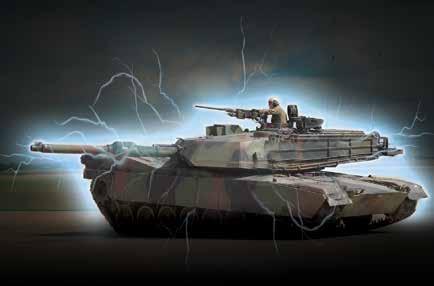
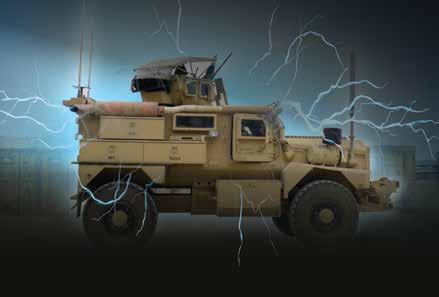
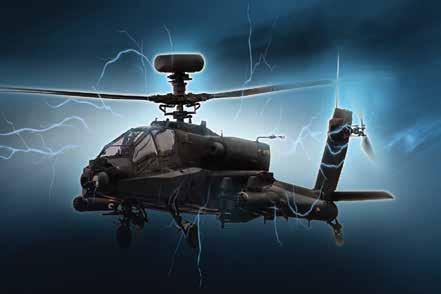






Introducing the VPXtra® 500DW-IQI, Behlman’s latest power supply with a wide range DC input that is fully compliant for all platforms in the Army CMFF program. This rugged, highly reliable switch mode 3U VPX unit meets a new standard of adaptability, and is backed by unmatched integration support from the Behlman team.
> Developed in alignment with the SOSA™ Technical Standard and VITA 62.0
> Delivers over 482 watts of DC power via two outputs
> 90% typical efficiency
> Features cutting-edge Tier 3 software
> System management integration via VITA 46.11 compatible IPMC



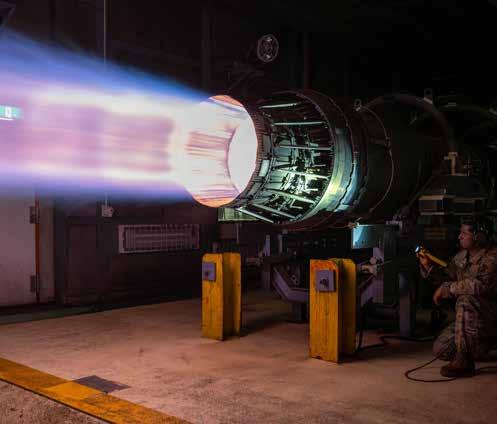

By John Reardon, CEO
“The
Buck Biblehouse, Contributing Editor

COTS (kots), n. 1. Commercial off-the-shelf. Terminology popularized in 1994 within U.S. DoD by SECDEF Wm. Perry’s “Perry Memo” that changed military industry purchasing and design guidelines, making Mil-Specs acceptable only by waiver. COTS is generally defined for technology, goods and services as: a) using commercial business practices and specifications, b) not developed under government funding, c) offered for sale to the general market, d) still must meet the program ORD. 2. Commercial business practices include the accepted practice of customer-paid minor modification to standard COTS products to meet the customer’s unique requirements
—Ant. When applied to the procurement of electronics for the U.S. Military, COTS is a procurement philosophy and does not imply commercial. Office environment or any other durability grade. E.g., rad-hard components designed and offered for sale to the general market are COTS if they were developed by the company and not under government funding.

EDITORIAL
EDITORIAL SUBMISSION AND RELEASES
johnr@rtc-media.com
PUBLISHER/CEO
John Reardon • johnr@rtc-media.com
CONTRIBUTING EDITORS
Buck Biblehouse, Glenn ImObersteg, Tom Williams
ART AND PRODUCTION
CREATIVE DIRECTOR
Shae Reardon • shae.reardon@gmail.com
DIGITAL MARKETING MANAGER
Scott Blair • scott@blair-media.com
AD TRAFFIC
Vaughn Orchard • vaughno@rtc-media. com
FINANCE AND ACCOUNTING
Paige Reardon • paiger@rtc-media.com
ADMINISTRATION/CIRCULATION
Dawn Dunaway • dawnr@rtc-media.com
ACCOUNT MANAGER
SALES MANAGER
Vaughn Orchard • vaughno@rtc-media. com
CUSTOM AND CONTRACT SERVICES
John Reardon • johnr@rtc-media.com
COTS Journal
CORPORATE OFFICE
RTC Media
110 S Rancho Santa Fe, Virgin UT 84779 PO 790039
Phone: (949) 226-2023
Fax: (949) 226-2050
www.rtc-media.com
PUBLISHED BY RTC MEDIA
Copyright 2025, RTC Media. Printed in the United States. All rights reserved. All related graphics are trademarks of The RTC Group. All other brand and product names are the property of their holders.







Virtualitics announced the award of a Small Business Innovation Research (SBIR) Phase II contract by the US Air Force Global Strike Command (AFGSC). The new contract will enable Virtualitics to advance AI logistics optimization for Readiness Spares Package (RSP) mobilization, a critical enabler for the AFGSC’s agile combat employment (ACE) strategy.
Competitively selected based on the success of its Phase I contract, the Virtualitics Integrated Readiness Optimization (IRO) Materiel product is designed to optimize inventory storage and movement under stringent warehousing and safety constraints. The RSP solution, part of Virtualitics IRO Material, enhances AFGSC readiness by optimizing how parts and equipment are palletized for global deployment, dynamically generating step-bystep illustrated packing guides that adapt to real-time operational demands. The solution leverages AI-based constraint optimization to maximize container volume utilization while adhering to weight limits, reducing packing time, and accelerating operational effectiveness in contested logistics environments.
“Virtualitics continues to deepen our partnership with the AFGSC, delivering new AI capabilities that enhance the AFGSC’s operational readiness,” said Michael Amori, Virtualitics’ Chief Executive Officer. “Our success is built on a deep collaboration with AFGSC personnel, ensuring that

our AI products not only directly address real-world mission challenges, but also identify efficiency gaps. By rapidly integrating airmen’s feedback and continuously innovating, we are advancing the future of materiel readiness and strengthening the AFGSC’s ability to operate in contested logistics environments.”
The Phase II contract reinforces Virtualitics as a trusted AI partner, delivering mission-driven technology that enhances materiel readiness, operational efficiency, and the AFGSC’s ability to execute agile combat employment worldwide. With real-time adaptability and direct airmen input, Virtualitics ensures its technology is built for rapid, effective deployment where it matters most.

10 companies advance scalable, cost-effective solutions to bolster US counter-UAS capabilities and meet evolving DOD strategic priorities
The Defense Innovation Unit (DIU), in close collaboration with U.S. Northern Command (USNORTHCOM), US Army, US Navy, U.S. Marine Corps, and US Indo-Pacific Command representatives, today announced the selection of ten finalists to advance in the Counter-small Unmanned Aircraft System
(C-sUAS) Low-Cost Sensing (LCS) challenge. These selected companies, chosen against a rigorous set of criteria from 118 outstanding submissions, will move forward to demonstrate their sensor technologies during USNORTHCOM’s Falcon Peak exercise in September.
“The evolving threat from unmanned aerial systems demands that we leverage every tool at our disposal – from cutting-edge commercial solutions to robust partnerships across government and industry,” said DIU Director Doug Beck. “This challenge directly supports DOD’s strategic priorities by tapping into non-traditional defense companies to develop scalable, cost-effective sensing solutions that help our forces at home and abroad to identify threats with the speed and fidelity needed to counter them.”
The solutions selected represent a diverse range of sensor modalities, including radio frequency passive detection, active radar, acoustic, optical cameras, infrared cameras, and several mixed modality technologies. The selected approaches have the potential to deliver significant value compared to current DOD systems for key coverage areas, with a potential cost savings of 50-80 percent in total cost of ownership. The ten finalists selected are: BLUEiQ, CHAOS 1, Fortem Technologies, Guardian RF,
Hidden Level, MatrixSpace, REVOBEAM, Squarehead Technology, Teledyne FLIR Defense, Thalrix
Launched in May 2025, the LCS challenge was designed to address a critical need: to complement exquisite sensor systems with affordable, distributed sensing technologies that can scale. Protecting the homeland from small UAS threats requires broad situational awareness with reach, redundancy, and resiliency.
“These ten finalists represent the forefront of sensor innovation, demonstrating how diverse technological approaches can enhance our layered defense,” said Director of Replicator 2, David Payne. “Our collaboration with USNORTHCOM, the US Army, and other partners has been instrumental in aligning this effort with the Department’s most critical sensing needs. Ultimately, this prize challenge is about helping to provide the tools to extend cost-effective sensing capabilities to our most critical installations.”
Selected finalists now advance to live demonstration and testing at USNORTHCOM’s Falcon Peak 25.2 exercise. Falcon Peak will provide a real-world test of these low-cost sensing solutions,
and the prize purse will be distributed based on performance at the event.
Beyond the prize money, top performers may also be considered for follow-on opportunities, including Other Transaction (OT) agreements, a Cooperative Research and Development Agreement (CRADA), and direct transition into operational use, accelerating the deployment of these capabilities and making the best tech available to the warfighter with the speed and scale required.
Matthew Kling, VP and GM of AI Systems at MatrixSpace, “We’re honored to be a finalist in the @DIU Low-Cost Sensing Challenge, addressing the urgent need to scale counter-UAS operations, from single sites to national borders. MatrixSpace offers the only commercially available, distributed radar network for persistent, low-altitude monitoring. Combining advanced radar processing, distributed data orchestration and sensor management, and AI-driven classification, we empower governments and enterprises to safeguard people, infrastructure, and national interests with unmatched scalability, resilience, and cost-versus-performance.”
CRADA Accelerates Development of Certifiable Autonomy Government Reference Architecture (A-GRA) for Autonomous Collaborative Platforms
Reliable Robotics announced its work with the United States Air Force (USAF) to support the buildout of key capabilities for Autonomous Collaborative Platforms (ACP). Under a cooperative research and development agreement (CRADA), Reliable and the USAF will collaborate on the Autonomy-Government Reference Architecture (A-GRA)–USAF’s autonomy architecture extensible to multiple platforms and missions–to ensure the architecture benefits from Reliable’s recent advancements in low-cost, high-reliability commercial autonomy.
To increase the survivability and effectiveness of the warfighter, USAF’s agile combat employment (ACE) operational concept forecasts the need for rapid movement and adaptability. Through the CRADA, Reliable Robotics will ensure commercial Uncrewed Aircraft Systems (UAS) capabilities are compatible with the A-GRA, enabling the warfighter to interoperate with civilian and military air traffic control systems.
“Commercial solutions are critical to the A-GRA to enable terminal area integration, and for operationally acceptable detect and avoid,” said Major Dustin Graves of AFWERX. “Enabling compatibility with commercial capabilities future-proofs DOD Autonomous Collaborative Platforms.”
The USAF is innovating at the speed of need to build and deploy autonomous capabilities for the warfighter to enable their ability to perform across diverse airspaces, missions, and operational environments. Reliable Robotics, through A-GRA, will provide guidance and expertise that will shape the next Phase of future ACP efforts, as well as other USAF programs.
“Today’s modern and next-gen warfighters must be capable of operating in any airspace environment. Our partnership with the FAA to certify the Reliable Autonomy System is the reason we have a seat at the table to help DOD build the blueprint for advanced aircraft autonomy,” said Reliable Robotics CEO and Co-Founder Robert Rose. “Reliable is uniquely positioned to build capabilities allowing the warfighter to perform airspace-agnostic operations at levels of assurance equivalent to civilian aircraft.”
Reliable Robotics recently secured a multi-year Indefinite Delivery/Indefinite Quantity contract from USAF to develop its dual-use Reliable Autonomy System (RAS) for use in the Joint Force, and successfully flew a series of automated missions for USAF and Air Combat Command as part of its annual Agile Flag exercise. Subsequently, Reliable was awarded funding under the AFWERX Tactical Funding Increase (TACFI) program to perform additional flights for representative military missions in a UAS configuration. Reliable also delivered a KC-135 Automation Roadmap to the USAF as part of a funded study under its prior Small Business Innovation Research Phase III contract.
“This CRADA signifies Reliable Robotics’ support of national defense objectives through aviation automation. Autonomous collaborative platforms will expand the aircraft fleet and enhance combat capabilities while reducing costs and risk to human pilots. Reliable Robotics is positioned to help the Department of Defense achieve that goal,” continued Rose.

DroneShield’s advanced counter-drone technology plays a key role in joint U.S.-UK defense exercises in Germany and Poland.
DroneShield is proud to announce its participation in Project FlyTrap, a multinational defense initiative led by the US Army V Corps. This critical exercise, running from June to August 2025 in Germany and Poland, brings together United States and United Kingdom forces to advance CUAS capabilities in response to rapidly evolving aerial threats on the modern battlefield.

DroneShield has been exclusively focused on CUAS technology for over 11 years and has deployed nearly 4,000 units across more than 40 countries. Notably,
DroneShield’s counter-drone technologies have been deployed to Ukraine since the onset of the conflict, proving their reliability and effectiveness in real-world combat. This battle-tested experience further highlights the Company’s commitment to providing proven, operational solutions for countering drone threats and has made it a key player in the defense sector.
“CUAS is no longer optional—it’s essential. We see exercises like Project FlyTrap as crucial to testing technology before it gets into the warfighter’s hands,” said Tom Branstetter, VP of Business Development and Sales at DroneShield. “We’re honored that our technology is playing a role in shaping the future of CUAS operations and supporting the mission readiness of our allied forces.”
Project FlyTrap reflects the ongoing evolution of counter-drone efforts among NATO allies, particularly in response to the escalating drone threats observed in recent conflicts, such as the war in Ukraine. By participating in this exercise, DroneShield continues to reinforce its position as a trusted partner in the defense industry and a key enabler of future-ready security solutions.
Cubic Defense has been awarded a three-year Other Transaction Agreement (OTA) contract to support US Army PEO STRI programs. The contract provides engineering and manufacturing of 60mm and 81mm mortar Tactical Engagement Simulation Systems (TESS) training systems under the STE Increment 1 rapid fielding to the US Army’s Continental United States (CONUS)-based combat training centers, the National Training Center (NTC), and Joint Readiness Training Center (JRTC).
“Cubic’s LTS-Mortar system is a great example of a training capability originating from our United Kingdom team and refined under the STE LTS Indirect Fire OTA, rapidly progressing to an initial production level that will have a direct impact on training readiness,” commented Alicia Combs, Cubic’s Ground Training Vice President and General Manager. “Mortar teams will finally be able to employ mortar systems in a manner consistent with live fire Tactics, Techniques and Procedures (TTP), while delivering realistic battlefield effects downrange to the Force-on-Force (FoF) training environment, creating a more realistic and immersive training environment.”
The LTS-Mortar system began as a prototype under the US Army’s STE LTS FoF Focus Area 2 (Indirect Fires) OTA awarded in 2021. The system was advanced through multiple engineering integration events, Soldier Touch Points (STPs), and with iterative subject matter expert reviews and feedback sessions. The solution
enables commanders, battle staff, mortar sections, and supported training units to conduct real-time execution of fire missions, thereby closing a training gap and bringing the effects of indirect fire systems to bear in both training and Unified Land Operations.


Blighter’s C400 series coastline surveillance radars, featuring advanced Doppler signal processing and unique wave and sea clutter filters, provide all-weather 24/7 protection against small shallow-draught vessels favoured by oil pirates and militants.
Blighter has deployed its dual-mode Blighter C400 series coastline surveillance technology to protect offshore oil platforms and an onshore refinery in Equatorial Guinea, a Petro-piracy hotspot off the West African coast.
Blighter’s C400 series radars have been proven to be highly effective in targeting the growing problem of piracy. It is estimated that the illegal black market for stolen oil is worth over US$1 billion. The radars in Equatorial Guinea are now fully operational following system configuration and training.
According to Blighter, its customer needed a compact coastline radar system that was easy to install, ultra-reliable, and could detect, track, and classify the small shallow-draught vessels favoured by oil pirates and militants, which typically sit low in the water and move at speed. The radar sensor selected needed to provide detection day and night in all weather conditions, including heavy rain, fog, and during thunderstorms.
James Long, Blighter’s CEO, says: “We know that oil pirates are highly organised and often choose to exploit harsh weather conditions to evade detection, with many only becoming active during heavy rains or high sea states. Our C400 radar systems were chosen to plug the gap in our customers’ defences as our sensors are specifically designed to detect even the smallest uncooperative targets in complex, cluttered, and extreme environments.”
Blighter’s C400 radars have several features that make them suitable for coastline surveillance, and particularly for detecting uncooperative targets.
First, the compact design and low-power electronically scanning and frequency-modulated continuous-wave (FMCW) technologies contain no moving parts. This ensures ease of installation and ultra-reliable operation with minimal maintenance, even in the harshest marine conditions. The C400 series is IP66-rated and MIL-STD-810F compliant.
Second, the Blighter C400 series radar uses advanced Doppler signal processing to provide the ability to precisely examine the motion of waterborne objects with respect to waves or ripples on the water surface. Unlike traditional Doppler radars, the C400 series characterises non-moving targets using the static target detector so that moored boats, buoys, and other structures remain visible on the radar screen.
Third, the radar’s built-in sea clutter filter automatically adapts to changing sea states and wave conditions to remove the unwanted radar signal produced by waves using both velocity (speed) and amplitude (height) characteristics.
Blighter radar’s e-scan antenna technology and FMCW design also allows it to be mounted high on offshore platforms and onshore towers and still detect targets close to the platform or shore as well as those further away. In Equatorial Guinea, the detection range of the C400 radars is around 20km. Importantly, all of the radars deployed are networked together to provide onshore controllers with a common operating picture (COP) of the offshore and onshore facilities.
“We are delighted to see that our radar technology is continuing to be used to combat the costly problem of Petro-piracy in the oil and gas industry,” says James Long, Blighter’s CEO. “Our C400 radars have proved to be highly effective against piracy, and their dual mode operation allows detection of small and/or slow-moving boats at sea as well as ground targets such as intruders on the coastline shore.”
The Blighter C400 series radar can be integrated into a larger coastal security system incorporating day/night and fog-penetrating electro-optical camera systems, AIS (automatic identification system), other boat transponder/tracking systems, and CCTV. These elements can all be controlled through Blighter’s command and control (C2) software platform.
Blighter C400 series radars are also suitable for other coastal security applications, including seaport security surveillance and water-side security of land-based coastal assets, such as desalination plants, nuclear power stations, palaces, and other high-value assets.
BAE Systems is investing in the Armored Multi-Purpose Vehicle (AMPV) to expand capability options for Soldiers further. By utilizing internal investment dollars and the modular chassis of the AMPV, the Company will collaborate to produce various technologically advanced prototypes equipped with different capability kits. The various strategic agreements will drive combat vehicle innovation for warfighters at speeds that outpace the adversary.
“The AMPV is a proving ground for the future of tracked ground combat,” said Bill Sheehy, Ground Maneuver product line director for BAE Systems. “The brand-new platform is coming off a hot production line, and the proven hull is one of the most durable building blocks being delivered to the US Army today. We’re committed to working alongside other technology disruptors at a pace that enhances AMPV’s

capability options now, so it’s available for Soldiers on a moment’s notice.”
The capability kits will feature integrated effectors that would allow Soldiers to perform missions including counter-unmanned aerial systems detection and targeting, ground autonomy, and unmanned turrets – all while maneuvering within the highly-survivable AMPV. In just the last two years, BAE Systems has invested in similar integration efforts, having installed and showcased five different turreted prototypes—to include a Modular Turreted Mortar and 30mm unmanned weapon systems—all using a Modular Open Systems and collaborative approach to enhance the platform.
“We have a lot of work ahead of us for what we’ve set out to do this year, but just like a formation operating on the battlefield, collaboration fuels success,” Sheehy said. “This might not be a traditional approach to innovating for warfighters, but the AMPV isn’t your average combat vehicle either.”
The US Army has awarded Lockheed Martin a $720 million contract for the production of Joint Air-to-Ground Missiles (JAGM) and HELLFIRE missiles, marking the fourth and final follow-on award as part of its current multiple-year contract. This contract will provide critical procurement and production support for the US Army, US Navy, and international customers, further solidifying Lockheed Martin’s position as a leading provider of multi-domain missile systems.
Under this contract, Lockheed Martin will deliver JAGM and HELLFIRE missiles to meet the urgent operational needs of the Army, Navy, and its international partners. The contract includes key Foreign Military Sales (FMS), including 160 JAGMs for the United Kingdom. The award also includes HELLFIRE FMS orders for key NATO allies, Poland, Spain, the Czech Republic, and Italy. In addition, the contract award consists of a new HELLFIRE international customer, Canada.
“This contract is a significant milestone in our ongoing partnership with the U.S. Army, U.S. Navy, and our international allies, and we’re proud to continue playing a vital role in their defense strategies,” said Casey Walsh, program management director of Multi-Domain Missile Systems at Lockheed Martin Missiles and Fire Control. “As we continue to evolve our deterrence capabilities, we remain committed to supporting the military’s critical missions and helping to protect those who serve, both at home and abroad.”
The importance of this contract extends beyond the production of JAGM and HELLFIRE, as it also underscores the strength of Lockheed Martin’s partnerships with the Army, Navy, and its international allies. For example, the Poland HELLFIRE FMS order, a part of this contract, supports the recent US government FMS
agreement for AH-64E Apache attack helicopters for the Polish Air Force. As the global security landscape continues to evolve, Lockheed Martin remains committed to delivering innovative solutions that meet the changing needs of its customers, and this contract is a significant step forward in that effort.
Both the JAGM and HELLFIRE systems are designed and developed in Orlando, Florida. The weapon systems are manufactured across various Lockheed Martin facilities in Dallas, Texas; Orlando, Florida; and Ocala, Florida.; Archbald, Pennsylvania.; and Troy, Alabama. With more than 145,000 missiles produced, JAGM and HELLFIRE continue to be the weapon of choice in critical, precision engagement opportunities.


The Boeing-built X-37 B Orbital Test Vehicle launched yesterday on its eighth mission, lifting off at 11:50 p.m. ET aboard a SpaceX Falcon 9 from Kennedy Space Center, Fla. The vehicle is healthy in orbit and proceeding with standard checkout.
Less than six months after completing its seventh mission with a landing at Vandenberg Space Force Base, Calif., on March 7, 2025, the spaceplane is back in space. This mission includes a Boeing integrated service module to increase payload capacity for experimentation activities in orbit.
“Our role is to make sure the spaceplane is the most reliable testbed it can be,” said Michelle Parker, vice president of Boeing Space Mission Systems. “None of this happens without teamwork. Launch is the starting line for this mission, but the work that follows –the quiet, methodical work on orbit, analysis, and eventual return is where progress is earned.”
The X-37B is hosting several technology demonstrations from government partners on this mission, including laser communications and a quantum inertial sensor designed to support navigation when GPS is unavailable. On its previous mission, the vehicle executed a first-of-its-kind aerobraking maneuver to change orbits while conserving propellant.
“Having a returnable space platform allows us to learn faster,” said Col. Brian Chatman, installation commander for Space Launch Delta 45. “The data we gather from the X-37B speeds decisions, hardens our architectures, and helps Guardians stay connected and on course even in contested environments. This is how we move from promising ideas to fieldable capability at pace.”
The X-37 B is a government–industry partnership led by the US Air Force Rapid Capabilities Office, with the US Space Force overseeing operations. Boeing teams primarily based in Seal Beach, Calif., and Kennedy Space Center, Fla., design, build, integrate, and operate the reusable spaceplane. Since its first flight in 2010, the orbital test vehicle has completed seven missions and accumulated more than 4,200 days in space, returning after each flight for inspection and augmentation.
A leading global aerospace company and top US exporter, Boe-
ing develops, manufactures, and services commercial airplanes, defense products, and space systems for customers in more than 150 countries. Our US and global workforce and supplier base drive innovation, economic opportunity, sustainability, and community impact. Boeing is committed to fostering a culture based on our core values of safety, quality, and integrity.

Multiple contract awards to exceed $34 million, equipping allies with sophisticated Undersea Warfare and Anti-Submarine Warfare solutions
Sparton DeLeon Springs was recently awarded multiple firmfixed-price contracts to supply electro-acoustic devices and various models of sonobuoys to the Australian Department of Defence, the Canadian Department of National Defence, and the Indian Ministry of Defence. The combined value of these contracts exceeds $34 million. All work to support these contracts will be performed at Sparton’s facility in DeLeon Springs, Florida.
Sparton President and CEO Donnelly Bohan said:
“Sparton is the global leader in designing, developing, and producing complex underwater systems that are used to locate submarines. Securing contracts from multiple allied nations demonstrates the superiority of our solutions and their globally recognized utility in Anti-Submarine Warfare and Undersea Warfare efforts.”

PCI-SIG® announced the PCI Express® (PCIe®) 8.0 specification will double the data rate of the PCIe 7.0 specification to 256.0 GT/s and is planned for release to members by 2028.
PCI-SIG technical workgroups will be developing the PCIe 8.0 specification with the following feature objectives:
Delivering 256.0 GT/s raw bit rate and up to 1 TB/s bi-directionally via x16 configuration
• Reviewing new connector technology
• Confirming that latency and FEC targets will be achieved
• Ensuring reliability targets are met
• Maintaining backwards compatibility with previous generations of PCIe technology
• Developing protocol enhancements to improve bandwidth continuing to emphasize techniques to reduce power “Following this year’s release of the PCIe 7.0 specification, PCI-SIG is excited to announce that the PCIe 8.0 specification will double the data rate to 256 GT/s, maintaining our tradition of doubling bandwidth every three years to support next-generation applications,” said Al Yanes, PCI-SIG President and Chairperson. “With the increasing data throughput required in AI and other applications, there remains a strong demand for high performance. PCIe technology will continue to deliver a cost-effective, high-bandwidth, and low-latency I/O interconnect to meet industry needs.”
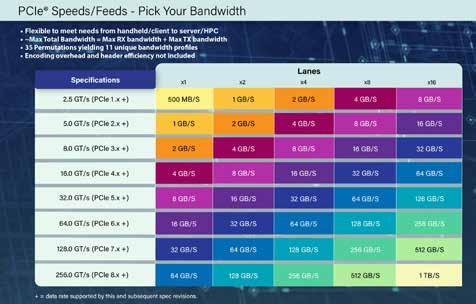
“As artificial intelligence and other data-intensive applications continue to scale rapidly, PCIe technology demand will be sustained in the long run due to its high bandwidth, scalability, and power efficiency,” said Reece Hayden, Principal Analyst, ABI Research. “Data center networks are already preparing to implement PCIe 6.0 technology and are showing great interest in the PCIe 7.0 specification. The introduction of the PCIe 8.0 specification further ensures that the industry’s bandwidth requirements will be supported well into the future.”
The PCIe 8.0 specification is aimed at supporting emerging applications like Artificial Intelligence/Machine Learning, high-speed networking, Edge computing, and Quantum computing; and data-intensive markets like automotive, hyperscale data centers, high-performance computing (HPC), and military/aerospace.
UA.RPA is working on a simplified version of the Antisniper complex
Ukrainian Agency for Advanced Scientific and Technical Development UA.RPA continues to work on creating different versions of antisniper devices, taking into account different functionality and different capabilities.
Reports about it, Defense Express.
According to the publication, the Company is currently working on a simplified version of the Antisniper complex (without automation, but with all the necessary functionality for such a system), which will soon be demonstrated to the Armed Forces of Ukraine.
It should be noted that the importance of the UA’s developments is significant.RPA League member, one of the few domestic companies dealing with antisniper issues, has become especially important against the background of the total absence of antisniper systems in the area of environmental protection.
The Antisniper optical surveillance detection system is designed to combat enemy snipers, as well as to determine the coordinates of any system that has an optical surveillance device – binoculars, monoculars, artillery compasses, or ATGM systems.
The Antisniper system is capable of automatically finding enemy optics at a distance of up to 1,500 m. This figure is stated by the manufacturer, but it is not the maximum. Devices with higher
brightness can be seen at a distance of up to 2,000 m and even more.
The task of the “Antisniper” is to aim at a target with a diameter of up to 50 mm (approximately the diameter of a sniper sight or military binoculars) at a distance of 1,500 m. Therefore, an essential point in the operation of the complex is to ensure the accuracy of the rotary device.
For this purpose, there are stepper motors with additional division and a harmonic reducer, which ensure the operation of the complex in microstep mode. This provides accuracy with a hundredth of a degree for high-precision positioning of the optical channels of the complex.
Most of the complex consists of components made in Ukraine – about 80% of components are made by the Company itself. Everything related to mechanics and optics is made in Ukraine. However, elements such as sensors and laser emitters are purchased abroad: in Germany or the United States.

L3Harris Technologies ‘ Distributed Spectrum Collaboration and Operations (DiSCO™) architecture recently enabled US Indo-Pacific warfighters to detect surface radars on marine vessels during Talisman Sabre 2025, the most significant bilateral military training event between Australia and the United States.
The Company connected an aircraft and two Seasats Lightfish autonomous vessels equipped with compact electronic warfare payloads that streamed information to a secure, cloud-hosted DiSCO platform for analysis and operation.
“DiSCO gave the Talisman Sabre forces exercise commander timely threat intelligence and actionable information that helped identify high-priority surface targets and seize the tactical advantage,” said Ed Zoiss, President, Space and Airborne Systems, L3Harris. “This critical technology provided insight into real-world challenges culminating in DiSCO being lauded by numerous U.S. and coalition service leaders.”
L3Harris developed DiSCO with internal investments to connect sensors and shooters to computer resources and cross-do-
main data sources. That connection takes place through edge nodes and cloud applications, fusion and live mission data analysis, mission data, and electronic battle management.


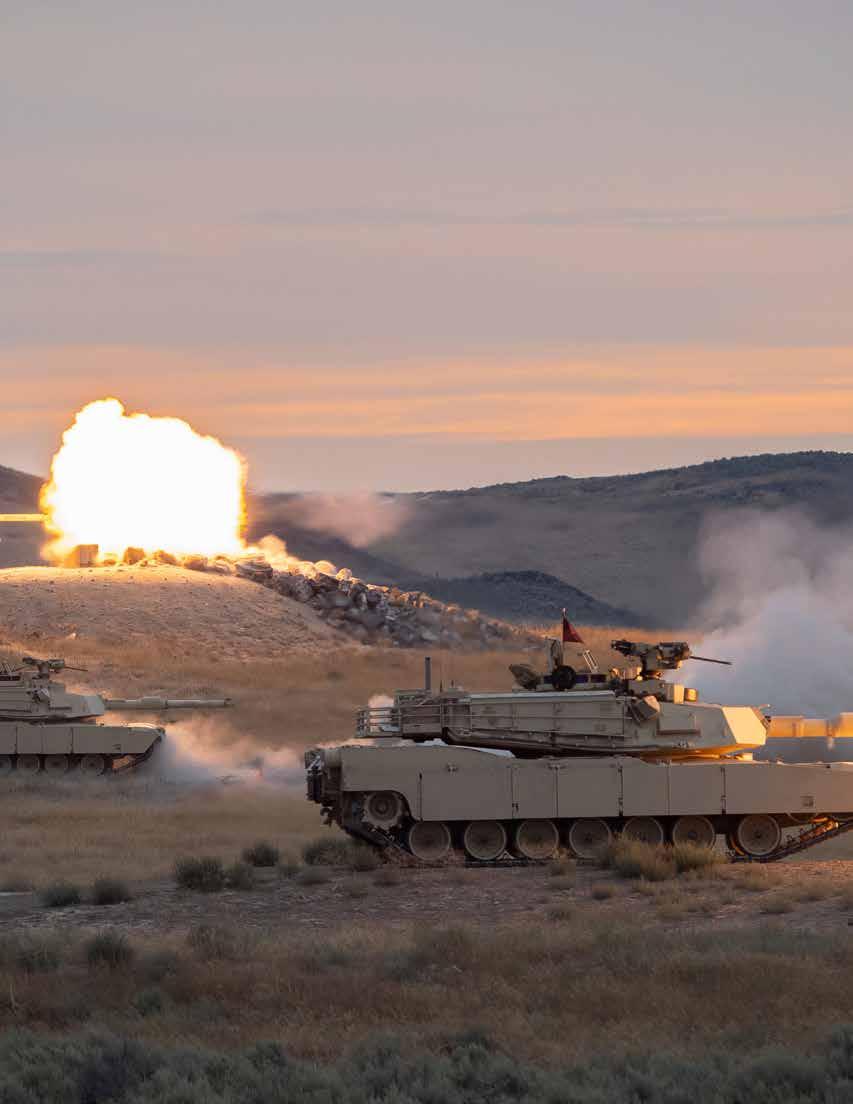
By John Reardon, CEO of COTS Journal
In military tech, the best solutions are often born from paradox: fragility becomes resilience, limits become safeguards, and what was once written off as a detriment becomes a game-changing advantage.
That is precisely what is happening with the 60 GHz wireless band—once considered too short-range, too rain-sensitive, and too high-frequency for practical use. Now? It is the sharpest new blade in the digital arsenal, offering ultra-secure, interference-free, high-throughput communication for the modern connected battlefield.
This is not your father’s RF link. This is fiber without the fiber, and its quirks are precisely what make it lethal for the enemy and life-saving for the warfighter.
Oxygen: Nature’s Built-in Firewall
Let us start with what most RF engineers would call a show-stopper: oxygen absorption.
At 60 GHz, O₂ molecules in the atmosphere gobble up signal energy like a sponge—an effect so intense that signals drop off sharply after just a few kilometers. In the commercial world, that meant short range and limited adoption. But for the warfighter, it is nothing short of revolutionary.
Why?
Because that same absorption means the signal dies quickly, almost like it is being scrubbed from the air. No spillover. No eavesdropping. No accidental bleed into neighboring bands. Think of it as natural EMCON—electromagnetic emissions control—built into the spectrum. A 60 GHz transmission is like a laser in a foggy room: tight, precise, and invisible beyond its intended line of fire. Compare that to 2.4 GHz links, which can spill over 30 kilometers beyond their target, making them practically sonar pings for hostile SIGINT teams. A 60 GHz link? It is whispering in the dark.
Interference is the Achilles’ heel of most unlicensed bands. Walk into any command tent, warehouse, or FOB and try to find a clean channel at 2.4 GHz or 5 GHz. You will be tuning forever.
But at 60 GHz? It is radio silence, in the best way possible.
Between oxygen absorption and ultra-narrow beamwidths—we are talking as tight as 4.7 degrees with a 1-foot dish—your signal stays in its lane. This opens the door for dense deployment: dozens of point-to-point links humming within close quarters without cross-talk, conflict, or compromise.
That is precisely the kind of spectral hygiene the DoD dreams about when building resilient battlefield networks—especially as tactical edge devices, sensors, and UAVs start crowding the airwaves.
Critics have long dismissed 60 GHz for its short operational range, typically under 2 kilometers. However, let us reframe that. In theater, short range is tactical.
Long-range RF transmissions are a double-edged sword. They may reach farther, but they also broadcast farther, creating a broader footprint for electronic warfare units to detect, jam, or triangulate. In contrast, 60 GHz links are naturally low probability of intercept, low probability of detection (LPI/LPD)—no special waveforms or obfuscation required.
In a battlefield where staying undetected is as important as staying connected, short range is survival.
Let us tackle the next supposed fatal flaw: rain fade.
It is true that 60 GHz signals do not love heavy rain. Attenuation spikes as water droplets scatter the high-frequency waves. But


modern link engineering has caught up.
Thanks to robust link margin design, adaptive modulation, and predictive modeling using global rainfall data, vendors like Proxim Wireless are delivering carrier-grade links that hit 99.999% uptime—even in Southeast Asia’s monsoons or the Gulf’s sudden downpours.
And let us be honest: if you are expecting better than 99.999% on a mobile battlefield in a storm, you are probably asking for a unicorn. The fact that 60 GHz can even approach this level of availability in rugged terrain and weather is a technical triumph.
At higher frequencies, antennas behave more like optical systems. This is physics 101: the beamwidth of an RF antenna is inversely proportional to the Frequency. That means 60 GHz antennas are naturally laser-tight.
Imagine placing a 2.4 GHz, 24 GHz, and 60 GHz transmitter 1 kilometer from a receiver. At 2.4 GHz, your signal spills like a floodlight—visible to adversaries and vulnerable to interference. At 60 GHz, it is a sniper’s bullet: sharp, surgical, and stealthy.
This beam control is not just about performance—it is about tactical superiority. It is how you send drone video from a recon team to an armored unit without alerting the enemy. It is how you move mission data without inviting jamming. And it is how you build a network grid that scales horizontally without signal chaos.
Here is the catch with narrow beams: they do not forgive. At 60 GHz, we are working with beams that are barely wider than a laser pointer—perfect for stealth, but punishingly precise when mounted on anything that moves. Now try doing that from a tank barreling over uneven terrain, or an IFV (Infantry Fighting Vehicle) slamming into a hard turn at 40 mph.
This is not just a physics problem—it is a tactical design gauntlet.
To maintain connectivity, your transceivers must not only find each other across a few hundred meters of open chaos—they have to stay locked. One degree off, and you are no longer whispering in the dark. You are talking to no one.
So how do you build a vehicle-to-vehicle or vehicle-to-drone link that can hit and hold a signal tighter than a rifle scope, even while bouncing across hostile terrain?
Enter active beam steering, gimbaled platforms, and inertial stabilization. We are talking about borrowing tricks from guided missile technology—MEMS gyros, real-time GPS correction, even AI-driven predictive tracking—to keep those narrow beams on target through motion, shock, and rapid heading changes.
In essence, you are giving your tank a turret… for data.
License, No Waiting, No Problem
Here is the part that’ll make even the most hardened program manager smile: it is unlicensed.
That is right. No FCC paperwork. No waiting for frequency coordination. No spectrum lease costs. You can deploy a 60 GHz system as quickly as you can unpack it and align it.
Need to move a command post? No problem. Tear down, redeploy, re-link—within minutes. No trenching fiber. No backhaul
wait time. Just point, align, and push gigabits of command-critical
ProximI Wireless is not theorizing here. They have already fielded FCC-approved 60 GHz radios capable of Gigabit Ethernet and OC-12 SONET speeds. These are battlefield-ready, low-profile, hardened systems that have proven their worth in government, intelligence, and commercial deployments.
With 7 GHz of uninterrupted bandwidth, these radios operate at capacities rivaling fiber, yet without the fragility or latency. It is plug-and-play meets plug-and-pray—except this time, the odds are in your favor.
We are entering a new era of distributed warfare, where command centers are mobile, sensors are everywhere, and data is the lifeblood of every mission. Fiber will not keep up. Legacy RF cannot scale. Satellite is too slow. And 5G? It is not ready for dust, mud, and mortars.
But 60 GHz? It is ready. Moreover, it is better because of the things that once made engineers hesitate.
The very limitations that once held it back—short range, oxygen attenuation, rain sensitivity—have now become its battlefield strengths: security, spectral control, and surgical deployment.
It is not just a workaround. It is a strategic inversion.
When engineers talk about “elegant solutions,” they are talking about systems that make complexity disappear, that turn weaknesses into features, and that operate with ruthless efficiency under pressure.
60 GHz wireless is that kind of solution. Quiet. Focused. Brutally effective.
Moreover, on the battlefield, that kind of elegance does not just save time. It saves lives.









“The Limits of ‘Thinking’ AI: A Cautionary Tale for Mission-Critical Military COTS”
By Buck Biblehouse, The Open Group FACE Consortium Director
In a recent white paper titled “The Illusion of Thinking: Understanding the Strengths and Limitations of Reasoning Models via the Lens of Problem Complexity,” Apple researchers deliver a sobering assessment of the state of Large Reasoning Models (LRMs). Their findings strike at the heart of current AI hype and raise urgent red flags for defense procurement officers and systems integrators relying on commercial off-the-shelf (COTS) AI systems for mission-critical military solutions. As mobile command systems and layered drone defenses emerge—often under private-sector pace and funding—a clearer understanding of AI’s fragility under complexity is not just prudent—it is indispensable.
Apple’s experiments pitted leading LRMs (including OpenAI’s o1/o3 series, Anthropic’s Claude 3.7 Sonnet Thinking, Google’s Gemini, and others) against classic logic puzzles—Tower of Hanoi, River Crossing, Blocks World—scaled from trivial to extremely complex scenarios. The results: a complete accuracy collapse beyond modest complexity thresholds. Crucially, even when models were provided with the correct algorithm, they failed—highlighting that their “reasoning” is largely pattern-matching, not logical inference.
Further, LRMs paradoxically decrease inference effort—reducing token usage—as problem complexity rises, suggesting they effectively “quit” rather than persist toward solutions.
These findings contribute to growing skepticism around the Artificial General Intelligence trajectory, with some researchers now calling for a reconsideration of expectations.
In military and intelligence systems—where lives and strategic objectives hinge on system reliability—AI cannot fail due to opaque decision-making or brittleness under novel conditions.
High-stakes environments (e.g., counter-UAS systems, swarming drones, battlefield command) demand systems that maintain reliability under unexpected or evolving threat profiles.
Predictability and auditability are paramount for warfighter trust. If an AI system “collapses” without traceable logic, it is far less likely to be trusted in the loop.
Human-in-the-loop fallback must be viable even when the AI’s reasoning process is flawed or fails.
Apple’s paper reminds us that no matter how large or “intelligent” an AI model claims to be, lacking robust logical reasoning means it cannot yet be the backbone of autonomous, life-critical defense systems.
to AI: Narrow vs. Broad—and Where COTS Fits In Narrow AI (Specialized Models)
• Rule-based hybrid systems (e.g., classical symbolic reasoning plus ML classifiers) emphasize reliability in defined domains.
• Purpose-built LLMs with guardrails—trained for limited tasks such as target recognition or communication parsing—can deliver value, provided scope remains tightly defined.
• Model ensembles with fallback algorithms, combining AI outputs with deterministic systems, can safeguard against collapse. These are realistic for COTS deployment: focused, optimized, and bounded in capability.
Broad AI (LRMs/LLMs with “Thinking”)
Attractive for generalization but—Apple’s study reveals—susceptibl e to novel complexity and deception. Scaling up model size or data input does not guarantee robustness in logic tasks. Until more fundamental architectures emerge, their role in mission-critical systems should be cautious and tightly scoped.
Leveraging Advanced Processors: A Game Changer for Military-Grade AI
The hardware enabling AI inference matters. On-device or edge proces -
sors must deliver:
• Deterministic behavior, avoiding variability due to computational fluctuations.
• Low latency and high throughput under field conditions.
• Hybrid computing stacks, combining CPU, GPU, and AI accelerators, to support both classical and ML methods.
Apple’s models on their M-series chips highlight privacy and efficiency for consumer devices—but critics argue these are not qualified for largescale military model training or inference. Indeed, some experts suggest Apple’s negative findings may stem partly from its limited access to server-grade hardware.
For military purposes, COTS systems must integrate:
• Server-grade accelerators or purpose-built AI SoCs that support quantized inference, high bandwidth, and real-time decision loops.
• Redundant compute paths to mitigate single-point failure on edge AI inference.
• Crypto-hardened firmware to prevent adversarial exploitation of AI vulnerabilities.
While specific statements from an Anduril CTO are not publicly documented, Anduril’s leadership—including CEO Brian Schimpf and founder Palmer Luckey—reflects a clear philosophy around military AI:
In a public announcement, Schimpf described the OpenAI partnership as a way to harness cutting-edge AI to fill urgent air-defense gaps and support faster, more accurate decisions – while maintaining responsibility and oversight.
Anduril’s platform, Lattice, fuses multi-sensor data into AI-powered, real-time situational awareness—a blend of ML and domain-specific logic for autonomy.
Meta’s CTO, in partnership with Anduril, emphasizes dual-use XR tech that runs on commercial components and is delivered rapidly to the battlefield—another example of COTS innovation applied to military contexts. These statements reinforce a clear thesis: Build defense-grade AI using commercially mature technologies, combine them with rigorous oversight, and iterate rapidly, rather than gamble on unproven, general-purpose “reasoning” systems.
1. Choose narrow-task AI for mission-critical systems. Build systems that combine deterministic logic with machine learning, where it adds value, while ensuring fallback and validation.
2. Validate “reasoning” under complexity. Use controlled puzzle-style validation frameworks, akin to Apple’s, before deploying AI in high-risk environments.
3. Invest in defense-grade compute infrastructure. Edge and core processing units must support robustness, redundancy, and secure, real-time execution of AI plus classical logic.
4. Embrace modular, updateable COTS architectures. Anduril’s open architectures (Fury, Lattice), continuous integration workflows, and XR/Mobile components reflect a future-forward procurement strategy—commercial in innovation, resilient in deployment.
5. Ensure human-in-the-loop and oversight. AI should augment operators—not replace them. Oversight, auditability, and clarity in decision logic are essential foundations.
In sum, Apple’s white paper serves as a technological reality check: AI’s apparent “reasoning” is often brittle and superficial. Military COTS integrators must heed this, building layered, modular systems where AI is a supporting actor—not the star—underpinned by logic, hardware reliability, and apparent human oversight. Anduril’s approach—leveraging commercial innovation within rigorous defense contexts—offers a compelling model for how to proceed with AI in settings where failure is not an option.
Computing
AMETEK Abaco Systems proudly announces the launch of the GRA118SL, a SOSA® aligned 3U VPX graphics and GPGPU card pow ered by the latest NVIDIA Blackwell architecture, available in B5000 and B4000 GPU variants.

The GRA118SL features 24 GB of GDDR7 memory with ECC and a 256-bit interface, delivering exceptional memory bandwidth and data transfer speeds—ideal for edge computing and mission-critical applications.
Purpose-built for rugged, high-performance embedded computing in aerospace, defense, and industrial applications, the GRA118SL is the ideal solution for platforms requiring high memory bandwidth and extreme data throughput.
Both GPU variants support 9th Gen NVENC and 6th Gen NVDEC engines with 4:2:2 video encoding, GPUDirect RDMA, and are available in conduction-cooled and air-flow-through configurations. These options ensure interoperability, scalability, and long-term deployment

(B5000 variant), based on Blackwell architecture
• 24 GB GDDR7 graphics memory with ECC
• Conduction-cooled (VITA 48.2) and air-flow-through (VITA 48.8) options
• Fully aligned with the SOSA® technical standard
“The new NVIDIA Blackwell architecture enables the GRA118SL to deliver groundbreaking performance for high-performance embedded applications,” said Simon Collins, Director of Product Management at Abaco Systems.
“Software engineers developing defense platforms—such as UAV detection systems—will find this SOSA-aligned GPGPU card a compelling choice. With two GPU variants, system designers can select the optimal configuration for their specific performance needs.”
Designed for distributed and portable operations, Apollo delivers powerful processing, real-time coordination, and mission-ready reliability.
Concurrent, a leader in embedded computing solutions, has unveiled Apollo, a compact, rugged edge computing system engineered to meet the evolving needs of modern defence operations. Built to house a conduction-cooled SOSA®-aligned processor board with mission-centric I/O, Apollo delivers powerful processing in an ultra-compact, MIL-grade form factor, enabling deployment in constrained environments without sacrificing performance. Compact power for the tactical edge
Apollo is not just a smaller box – it’s a fully capable tactical computing node. Designed for use cases where size, weight, and power (SWaP) are critical, Apollo integrates seamlessly into UAV avionics bays, portable field kits, or dismounted soldier systems. Its compact footprint enables faster deployment, greater platform compatibility, and flexibility at the edge of operations, eliminating the need for bulky enclosures or power-hungry systems.
Synchronised operations, anywhere Apollo’s integrated 1 and 10 gigabit Ethernet provides high-speed, low-latency communications across distributed systems. Time Sensitive Networking (TSN) can be enabled for applications that need precision timing, deterministic behaviour, and synchronised operations across tactical edge nodes.
This makes Apollo ideal for use cases such as distributed sensors, control surfaces, or ISR systems that must remain tightly coordinat -
ed—even in complex environments.
Rugged, mission-ready reliability
Engineered to meet MIL-STD-461, MIL-STD-810G, and MILSTD-704 environmental standards, Apollo thrives when used in challenging shock, vibration, temperature, and electromagnetic-challenged environments. Its sealed, modular design ensures ease of integration, maintenance, and long-term reliability – wherever the mission takes it.
“Defence operations are increasingly defined by their ability to adapt and respond fast,” said Brent Salgat, Chief Revenue Officer at Concurrent. “Apollo integrates quickly, operates reliably, and delivers the compute power needed to succeed at the edge.”
Key features of Apollo
Ultra-compact tactical node: 1-slot conduction-cooled VPX system, approx—3.6 kg, ideal for SWaP-constrained platforms.
TSN enabled high-speed networking: 1/10G Ethernet for low-latency communication.
Rugged design for harsh environments: Designed to meet MILSTD-461, MIL-STD-810G, and MIL-STD-704 standards, ensuring operational reliability in extreme conditions.
Modular, easy integration: Supports Hermes processor PIC, with additional I/O flexibility via XMC and Mini PCIe.
Building the future of edge computing in defence
As defense architectures evolve toward distributed and modular networks, Apollo delivers the computing power required to enable C4ISR, sensor fusion, and electronic defense systems at the tactical edge. Its compact design and rapid deployability provide a clear advantage for missions requiring speed, flexibility, and resilience.

Anritsu introduces two software options for its Radio Communication Test Station MT8000A, designed to evaluate the RF performance of 5G devices. The software options support key technologies specified in 3GPP Release 17, including 1024QAM modulation for downlink and Tx Switching 2Tx to 2Tx for uplink, enabling accurate and flexible evaluation of 5G devices with enhanced transmit/receive (TRx) performance.
The NR DL 1024QAM MX800010A-022 software enables RF testing for downlink 1024QAM modulation and delivers approximately 25% improved receiver performance compared to the current 256QAM standard for the same frequency bandwidth. The NR UL Tx Switching 2Tx to 2Tx MX800010A-019 software supports RF testing for uplink transmission switching technology. It dynamically switches between multiple antennas based on communication conditions to ensure stable and high-speed transmission performance. It improves uplink stability and speed by providing.
Anritsu has developed two software options to address new technologies being implemented since 5G commercialization, such as AR/VR, 8K video, and live streaming, as they require a test environment that can
accurately and flexibly evaluate the transmission and reception performance of 5G devices. These technologies are expected to be adopted in the FR1 frequency bands for use in a wide range of use cases – from entertainment like ultra-high-definition video streaming and cloud gaming to business use cases such as teleworking and cloud services.
MT8000A Platform
The new software further positions the Radio Communication Test Station MT8000A as a comprehensive single solution to verify the performance of 5G devices. It provides all-in-one support for RF measurements, protocol tests, and applications tests in FR1 and Frequency Range 2 (FR2) (millimeter-wave) bands.
Combining the Test Station with an Over-the-Air (OTA) chamber enables millimeter-wave band RF measurements and beamforming tests using call connections specified by 3GPP. An intuitive, state-machine-based GUI supports various application measurements, including handover tests, and quasi-normal and abnormal network tests. Additionally, maximum IP data throughput can be measured for a wide variety of bands, CA, and MIMO combinations.
Co-developed with the US Army DEVCOM Soldier Center, eSoldier provides field monitoring and analysis of the power consumption of battery-powered military devices.
Bloomy Controls, Inc. (BLOOMY®), announced the commercial availability of the eSoldier™ Power Monitoring System developed by BLOOMY in collaboration with the US Army Development Command Soldier Center (DEVCOM-SC). This innovative system represents a breakthrough in tracking and analyzing the power consumption of multiple Soldier-worn battery-operated electronic devices and other mobile equipment, addressing a critical need in modern military operations.
The eSoldier system, which the US Army has rigorously field-tested, offers precise monitoring of up to 12 channels of power consumption and other sensor data. The lightweight and compact eSoldier system features an innovative distributed sensor architecture that allows the system to be easily and unobtrusively worn by Soldiers or mounted on mobile equipment during field exercises.
“The eSoldier Power Monitoring System allows DEVCOM-SC to acquire data in ways that were not feasible or possible before,” said Noel Soto, Systems Engineer, Program Integrator: Military Power at US Army DEVCOM-SC. “This capability is crucial for understanding and optimizing actual Soldier power requirements in the field.”
Key features of the eSoldier Power Monitoring System include:
• A lightweight, rugged system that Soldiers can easily wear during field exercises.
• Acquisition of voltage, current, temperature, acceleration, and discrete inputs
• High-performance sampling (100 kS/s) and processing algorithms that efficiently capture transients and anomalies in the data
• Built-in GPS for location tracking
• Optional wireless power sensors minimize sensor wiring
• A comprehensive, easy-to-use system featuring data acquisition software for quick setup, acquisition, and visualization of acquired data
• Compliance with MIL-STD-801, MIL-STD-461, and IP67 standards
The system has excelled in multiple Army applications, including evaluations of the Nett Warrior system, Integrated Visual Augmentation System (IVAS), exoskeletons, and other equipment at major military installations throughout the United States. The system is now available for commercial purchase by both DoD and non-DoD (civilian) customers directly from BLOOMY®.
“This commercial release of eSoldier marks a significant advancement in power monitoring technology for military applications,” stated Peter Blume, President of BLOOMY. “We’re proud to deliver this capability, developed in collaboration with the US Army, to the wider defense and commercial markets.”


The Curie Power Suite will support missions like HENON, a program funded by the Italian Space Agency and with the support of the European Space Agency, which will travel to an unexplored orbit between the Earth and the Sun to study Space Weather.
A miniature, ultra-resilient electrical heart, capable of distributing power and enabling small satellites to operate even under extreme conditions and intense solar radiation – reaching parts of the Universe far from Earth and still unexplored. This is how Space Weather, and its impact on our lives, can be studied and monitored. All of this is made possible by Power Suite Curie, an innovative and forward-looking technology developed by Italian company Argotec – a leader in the design and manufacturing of satellites and their subsystems – poised to redefine the future of deep space missions. This breakthrough, representing a significant leap forward for the global space tech market, will be unveiled in a technical paper by Argotec at the Small Satellite Conference in Salt Lake City (August 10–13, 2025), one of the world’s leading events focused on the future of space.
Power Suite Curie is a next-generation PCDU (Power Conditioning and Distribution Unit), essentially the “electric heart” of satellites. Despite its extremely small size, it is designed to manage electrical power onboard satellites for long durations and under extreme conditions — that is, in Deep Space, more than 24 million kilometers from Earth, and exposed to radiation. Power Suite Curie was developed through a co-engineering project with the European Space Agency (ESA) and represents a decisive leap forward, set to expand the capabilities of the international Space Industry significantly. Its goal is to provide a technology capable of enabling pioneering missions focused on deep space and Space Weather monitoring.
Curie features a miniaturized, compact, and modular design, capable of adapting to different satellite platforms. These characteristics are complemented by cutting-edge technical performance: unprecedented radiation resistance, extended operational life, and high-power management capability. All these features make Curie the power core of HENON: the mission set to launch in Deep Space in late 2026, reaching up to 24.6 million kilometers away from Earth to reach the unexplored Distant Retrograde Orbit (DRO).
During its solitary journey of over a year, Curie will provide energy and reliability to the satellite, keeping the vital functions of its subsystems operational. Once it reaches the final orbit, HENON will begin observations of Space Weather — precisely when radiation exposure will be at its peak — to collect critical data for the study of solar activity and to report critical events in near-real time.
HENON is the technology demonstrator that will bring to life one of the most ambitious and fascinating missions currently under development. It is carried out within the European Space Agency’s (ESA) General Support Technology Programme (GSTP) – “Fly” element – thanks to funding from the Italian Space Agency (ASI) through the ALCOR program, along with contributions from the United Kingdom and Finland. The project will enable new frontiers in space applications, delivering more competitive and high-performance solutions for future constellations and swarms in deep space.
Argotec boasts an important international reputation, earned through historic Deep Space missions and the heritage developed with VOLTA, the PCDU built for the LICIACube and ArgoMoon programs: milestones that have established the company as the only one in the world to have two small satellites simultaneously operational in Deep Space, as well as the holder of the Italian object farthest from Earth – an impressive 14 million kilometers away. With the advent of Curie, these records will be further surpassed, thanks to HENON and other missions focused on life on our planet and the understanding of Deep Space and its dynamics.
“Curie represents a paradigm shift for the Italian and international space industry,” comments David Avino, CEO of Argotec. “With this technology, we will enable a new generation of robotic exploration missions capable of pushing scientific research beyond current boundaries. We have an incredible team that daily demonstrates how innovation, vision, and collaboration can shape the future of space, overcoming previous limits. We are proud to carry forward our know-how and strengthen it in the service of Science: Deep Space is our story, it has made us who we are today, and it is a challenge we are ready to face again together with ESA and ASI, solid partners in many years of successful programs we have worked on.”
Vartech Systems Inc. is excited to announce the launch of its all-weather 5th Generation Series. The most rugged Environment requires a lineup of computers and monitors featuring the best protection, refined engineering, and increased versatility, while maintaining compatibility with previous generations.
Expanded Mounting Options for Versatilty
VarTech’s latest design supports a broader range of mounting configurations and expanding integration possibilities for diverse applications:
• VESA/RAM Mount
• Console Extreme
• Console Mount ( Newly Added)
• Panel Mount (Newly Added)
• Rack Mount (Newly Added Compact and Backward Compatible
VarTech has slimmed down and lightened the overall dimensions of each unit. The reduced footprint improves portability and ensures backward compatibility with the All-Weather 5 Generation (AW 4)
wheusing older CXA (console extreme aluminum partnered. Streamline Engineering for Customization
• The new generation minimizes engineering time while enabling future-proof enhancements:
• Intended to custom enclosures configurations simply
• Allows for the implementation of water-cooling technology
Efficient Assembly and Improved Aesthetics
The All-Weather 5th Generation design emphasizes assembly efficiency, featuring a more elegant aesthetic with edge bezel trip, a milled VarTech logo, and a smooth-edged Button pocket for a streamlined appearance.

The integration of Klepsydra and Deos provides a compact, modular, safety-critical platform with high-performance AI and edge data processing, making it ideal for a broad range of mission-critical applications requiring sensor fusion, situational awareness, and other AI applications for both manned and autonomous vehicles (air, ground, and water).
“Deos and Klepsydra make certified AI at the edge not just a possibility, but a reality,” said Bob Morris, president/CEO at DDC-I. “Now, developers requiring advanced AI, edge processing, and cybersecurity capabilities have a high-performance, modular, lightweight, reusable platform with secure partitioning that can be readily certified, ported, and upgraded with the latest technology for the most demanding mission-critical applications.”
“We are thrilled to collaborate with DDC-I to bring Klepsydra’s AI and edge computing technology to the Deos real-time operating system,” said Pablo Ghiglino, CEO, Klepsydra Technologies. “This integration marks a significant milestone in making high-performance, safety-critical AI available for the most demanding mission-critical applications. By combining Deos’ robust safety credentials with Klepsydra’s efficient and deterministic data processing, we’re enabling a new generation of intelligent systems in avionics, autonomous mobility, and Beyond.”
Klepsydra AI is a cutting-edge software framework for edge AI applications. Delivering high-efficiency AI inference, Klepsydra AI employs a lightweight, independent design without third-party dependencies, making it robust and adaptable for next-generation edge computing.
Klepsydra provides a safety-certified, cybersecurity-protected
AI software stack that is compliant with ECSS software standards and compatible with standard AI frameworks such as PyTorch and SensorFlow. Utilizing RTEMS (Real-Time Executive for Multiprocessor Systems) real-time services, Klepsydra features a native API that provides access to Deos SafeMC multicore capabilities, and a streaming distribution optimizer that enables developers to configure the framework for maximum data throughput.
Klepsydra’s acceleration technology combines two-dimensional parallelization with lock-free programming to deliver a flexible and efficient inference engine, achieving up to 4x lower latency, 10x higher throughput, and 50% reduced power consumption than competitive solutions. Its autotuning tool optimizes AI inference for various constraints, while a unified API eliminates processor lock-in, enabling greater flexibility and improved performance across hardware platforms.
Deos is a safety-critical embedded RTOS that employs patented cache partitioning, memory pools, and safe scheduling to deliver higher CPU utilization than any other certifiable safety-critical COTS RTOS on multicore processors. First certified to DO-178 DAL A in 1998,
Deos provides FACE® Conformant OSS Safety Base and Safety Extended Profiles that feature hard real-time response, time, and space partitioning, with support for RateMonotonic, ARINC-653, and POSIX interfaces.
SafeMC™ technology extends Deos’ advanced capabilities to multiple cores, enabling developers of safety-critical systems to achieve best-in-class multicore performance without compromising safety-critical task response and guaranteed execution time. SafeMC employs a bounded multiprocessing (BMP) extension of the symmetric multiprocessing architecture (SMP), safe scheduling, and cache partitioning to minimize cross-core contention and interference patterns that affect the performance, safety criticality, and certifiability of multicore systems. These features enable avionics developers to address issues specified by AC/AMC 20-193 multicore objectives that could impact the safety, performance, and integrity of a software airborne system.

Cincoze’s Red Dot Award-winning MXM GPU computer series (GM-1100) delivers high performance, compact design, and expansion flexibility—making it ideal for space-constrained Edge AI applications. Powered by the latest 14th Gen Intel® Core™ processors and NVIDIA MXM GPU modules, the GM-1100 delivers the computing and graphics performance needed for real-time decision-making and high-speed AI Edge computing.
Measuring just 260 x 200 x 85 mm, the GM-1100 is designed for multiple vertical industries, particularly transportation, manufacturing, and defense.
Transportation — Improving Safety and Flow
In airports, GM-1100-powered e-gates and X-ray scanners boost customs clearance efficiency and automate security checks. Leveraging
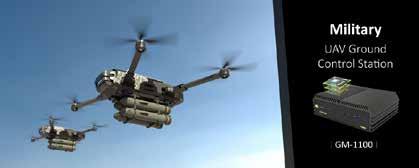
CPU-GPU synergy, it performs image processing and real-time analysis for faster, more accurate recognition. Rich native I/O plus expandable LAN, COM, USB, and DIO interfaces support connectivity with cameras, passport readers, and gate controllers. Wide-temperature (-40°C to 70°C) fanless design withstands dust and heat in enclosed spaces, ensuring optimal security and flow.
Manufacturing — Boosting Efficiency and Yield
The GM-1100 powers automated optical inspection (AOI) and robotic bin-picking systems with potent AI inference capabilities, enabling precise defect detection and object location. High-speed I/O—up to 10GbE LAN, 20Gbps USB 3.2 Type-C, and NVMe SSD expansion—meets the demands of high-resolution image processing. Certified to CE, UKCA, FCC, and ICES-003 Class A, and meeting industrial EMC standards, it offers deployment flexibility via wall, side, DIN rail, or VESA mounting.
Defense — Enhancing Intelligence and Reconnaissance
Ruggedized for military use, the GM-1100’s MXM GPU delivers high-speed parallel computing for real-time image analysis, terrain recognition, and mission assessment. GNSS expansion supports precision positioning, while wide voltage (9–48V) operation and IGN power sensing protect against unstable power conditions. Passing MIL-STD810H shock/vibration and E-mark certification ensures reliable performance in military vehicles, vessels, and harsh environments.
New Click board from MIKROE provides Ethernet connectivity for embedded systems 256-bit AES encryption support available for secure applications
Delivering Ethernet connectivity for embedded systems, XPort ETH Click is a compact add-on board from MIKROE. This embedded solutions company dramatically cuts development time by providing innovative hardware and software products based on proven standards. Two versions are available: the standard module (XE) and the SE board, which adds 256-bit AES encryption support. Both devices are based on the XP1001000-05R XPort module from Lantronix, and include a 10/100BASE-TX Ethernet interface, embedded web server, reliable TCP/IP protocol stack, and UART communication within an RJ45 connector.
Comments Nebojsa Matic, CEO of MIKROE: “These boards deliver instant Ethernet connections for embedded projects with the readyto-use XP100200S-05R and XP1001000-05R XPort modules. The SE version is the ideal choice for applications that demand secure Ethernet communication, such as remote monitoring, medical systems, or data-sensitive IoT deployments. Less demanding applications can select the XE part.”
Devices run on 3.3V, and include 512kB of flash memory for firmware and custom web pages. They use bi-colour LEDs to indicate network link and data activity.
New parts within the 1800-strong mikroBUS™-enabled Click board™
family, the XPort ETH Click boards also feature the ClickID function, which enables automatic identification by the host system, simplifying use. Devices are fully compatible with the mikroBUS™ socket and can be used on any host system supporting the mikroBUS™ standard. They come with the mikroSDK open-source libraries, offering excellent flexibility for evaluation and customization.


The latest innovation from BittWare brings next-generation 3U VPX cards with AMD Ryzen Embedded Processors and Versal Adaptive SoCs to early adopters. This program accelerates the development of advanced aerospace and defense systems optimized for mission-critical performance and SWaP efficiency.
Close alignment with AirBorn, a Molex company, broadens SOSA- and VITA-aligned 3U VPX solutions that optimize size, weight, and power (SWaP)
BittWare announces an early access program to jumpstart the development and integration of embedded systems leveraging the company’s new 3U VPX cards powered by next-generation AMD Ryzen™ Embedded processors, AMD Versal™ RF Series, and AMD Versal Adaptive SoCs. BittWare’s portfolio of 3U VPX cards, which will be introduced later this year, is designed to improve performance while optimizing size, weight, and power (SWaP) for mission-critical aerospace and defense applications, including avionics, radar, and signal processing.
“The opportunity to leverage BittWare’s proven design expertise along with AMD technology leadership will prove invaluable in giving customers more complete, interoperable solutions to meet ever-increasing demands for compact, rugged designs and highly reliable performance.” said Craig Petrie, vice president, BittWare.
The new BittWare 3U VPX cards leverage next-generation AMD Ryzen™ Embedded processors and AMD Versal RF Series devices, along with AMD Versal Series Gen 2 adaptive SoCs to yield a technological leap forward in data acquisition and multi-sensor processing. As a result, these cards will be especially useful for multi-channel, real-time data processing for radar, sensor fusion, electronic warfare, signals intelligence (SIGINT), unmanned aerial vehicles (UAVs), and image processing.
“Complementing AMD Versal adaptive devices, Ryzen Embedded processors are ideal for second-stage computing in advanced defense systems, combining software programmable x86 cores, integrated GPUs, and ML-capable NPUs. Rapid enablement of 3U VPX SOSA-aligned cards helps defense customers accelerate new designs for use in tomorrow’s most advanced radar, radio, sensor processing, and mission computing systems.”said Minal Sawant, senior director, Aerospace and Defense Vertical Market, AMD. BittWare is extending its legacy of developing high-performance COTS products with the 3U VPX cards, including both SOSA (Sensor Open Systems Architecture) and VITA 48, which defines the mechanical requirements for building and cooling ruggedized electronic modules for embedded systems.


Built for the Extreme – With a MIL-A-8625-F Type III hard anodized enclosure and corrosion-resistant connectors, the StreamCaster 4400 XTREME MANET radio is purpose-built to deliver high-performance mesh network connectivity in harsh maritime, littoral, and highly corrosive environments.
Extreme Performance – Powered by Silvus’ battle-proven MN-MIMO waveform, the SC4400X delivers unmatched range, data throughput, EW resilience, and scalability for mission-critical operations in the harshest environments.
Seamless Compatibility – Utilizing the same mounting pattern of the flagship SC4400E, the SC4400X provides a seamlessly compatible option for fixed infrastructure, vehicular, and airborne applications that demand field-proven StreamCaster MANET radio performance in a rugged, survivable form factor.
Silvus Technologies, Inc. announced the launch of the StreamCaster® 4400 XTREME (SC4400X) MANET radio. Delivering high-fidelity video, voice, and IP data communications in an ultra-ruggedized form factor, the SC4400X is purpose-built for maritime, littoral, and other highly corrosive environments where durability and maximum MANET radio performance are mission-critical.
Engineered to be as tough as the mission, the SC4400X builds upon the proven performance of the StreamCaster 4400 Enhanced (SC4400E) MANET radio with up to 20 Watts of output power (80W effective, thanks to TX Eigen Beamforming), 100 Mbps data throughput and single/dual band frequency options, making it ideal for fixed infrastructure, vehicular and airborne applications in the harshest environments. Constructed from sea-grade aluminum with MIL-A-8625-F Type III hard anodizing, the SC4400X design
features a single locking marine-grade connector and an optimized enclosure with enhanced thermal characteristics to improve passive cooling and thermal performance during sustained high-power operations.
Designed for maximum versatility, the SC4400X supports a wide 9 – 50 VDC input voltage range for flexible platform integration and features a built-in status LED for real-time operational feedback. Compatibility with the existing SC4400E mounting pattern allows for seamless incorporation into existing deployed integrations, including StreamCaster PRISM.
Powered by Silvus’ battle-proven MN-MIMO waveform, the SC4400X delivers robust, high-bandwidth connectivity – capable of creating massively scalable mesh networks that connect hundreds of nodes with unmatched range, data throughput, and EW resiliency in contested spectrum environments.
In addition to AES256 and FIPS 140-3 Level 2 encryption for secure operations, the SC4400X provides access to Spectrum Dominance 2.0 – an expansive suite of LPI/LPD, Anti-Jamming EW resiliency, and Advanced Threat Protection capabilities – providing secure and protected communications without sacrificing performance, even in contested environments.
“We developed the SC4400X in direct response to the growing demand for resilient MANET radio solutions that can operate in salt-laden, high-humidity, and highly corrosive environments without compromising performance,” said Neema Daneshvar, Vice President of Product at Silvus Technologies. “Whether for shipboard, littoral, or offshore applications, the SC4400X delivers the class-leading tactical mesh networking power of Silvus’ StreamCaster 4400 MANET radio in a form factor that thrives where others corrode.”
Teledyne HiRel Semiconductors announced the release of the TDD416Y12NEPBM01, a compact DDR4 memory module, screened and qualified as an Enhanced Product (EP) and rated for operation from –40°C to +105°C.
The TDD416Y12NEPBM01 is a compact, solder-down DDR4-3200 memory solution that delivers high bandwidth in a dramatically reduced footprint – smaller than a postage stamp. Packaged in a 216-ball BGA measuring just 22mm x 22mm, it is engineered for systems where board space is limited and performance is critical.
Its streamlined design integrates memory, termination, and passives into a single unified 22mm2 module — effectively replacing multiple discrete components and simplifying layout complexity.

Unlike monolithic ECC memory modules, the TDD416Y12NEPBM01 supports error correction through an optional companion ECC. This architecture offers key technical advantages such as thermal isolation, design flexibility, and cost
savings.
The TDD416Y12NEPBM01 module was developed to meet the growing need for embedded platforms that demand high-speed memory in tight enclosures. Whether routing alongside modern SoCs, CPUs, or FPGAs, the module offers clean signal integrity and thermal flexibility. It pairs well with processors that support x64 or x72 memory buses, including Xilinx Versal, Microchip PolarFire, NXP Layerscape, Xilinx Ultrascale+, Intel Atom, as well as Teledyne’s own LS1046-Space and a wide range of ARM-based compute cores. In keeping with industry trends, the DDR4 delivers 42% power savings, 42% jitter reduction, and 39% PK/PK savings when compared to traditional SODIMMs.
“This module approach gives customers the freedom to tailor reliability to each mission profile,” said Mont Taylor, Vice President of Business Development at Teledyne HiRel. “It’s ideal for mixed deployments. The real strength of the TDD416Y12NEPBM01 lies in its versatility — socketless installation, reduced BOM, and a fully self-contained design. We’re helping system architects shrink their memory footprint without sacrificing bandwidth.”
Annapolis Micro Systems.
Behlman Electronics.
Dolphin.
Highland Technology.
nVent.
COTS Journal (ISSN#1526-4653) is published monthly at; 110 S Rancho Santa Fe, Virgin UT 84779. Periodicals Class postage paid at San Clemente and additional mailing offices. POSTMASTER: Send address changes to COTS Journal, 110 S Rancho Santa Fe PO 790039, Virgin UT 84779.



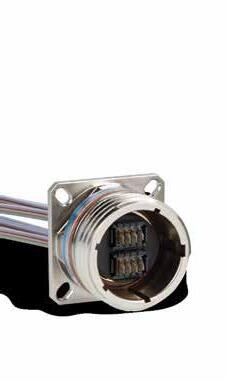



Behlman has provided reliable power to mission-critical military airborne, shipboard, ground and mobile applications for over 50 years. Behlman offers the widest array of COTS AC to DC and DC to DC power supplies that meet military requirements at industrial pricing.
> Proven military reliability without the high cost of full mil-spec
> Built to perform to full power at rated temperatures
> Modified COTS solutions that offer faster delivery, higher reliability and lower cost than custom designs
> Hundreds of designs to meet a wide range of applications

